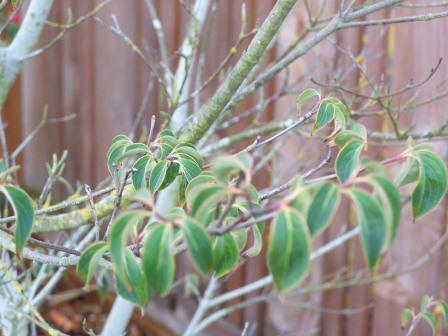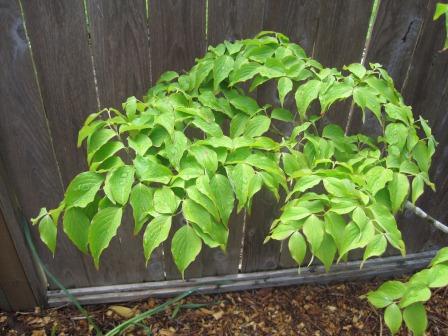What am I?

Answer on Monday!
A little more than a year ago I posted a Friday quiz based on a failing Cornus kousa.The answer explained that our landscape has, in part, a perched water table that effectively rotted most of the roots of this poor tree over several years. Last spring we moved it to a different section of our landscape where we know the drainage is better, and I’ve been monitoring its recovery since that time.

Cornus kousa leaves in 2007

Cornus kousa leaves in 2011
We were gratified to see that the leaves this year are significantly larger than those of previous years. This tells us that root function has resumed, providing enough turgor pressure to expand the leaves to normal size. It was especially helpful that we had one of the rainiest springs on record.
Take home lesson: if a tree or shrub is failing in its current location, it’s worth digging up to see what’s going on. Bad soil conditions? Move it to a better location. Bad roots? Time to hone your root pruning skills. But wait until fall to do this. Transplanting this time of year is the most difficult for plants because of the increased water demands of warmer temperatures and expanding leaves.
Today I was reading a review of Amy Stewart’s new book Wicked Bugs and noticed the glee with which the reviewer noted that stings of various insects have been rated on a four point scale. Having read Amy’s book I can wholeheartedly recommend it, but in terms of the stings I thought, what the heck? Let’s see if I can impart some glee to our readers by taking a look at the pain that stings cause (I think it’s kind of like highbrow slap-stick). So here is a brief review of sting science over the years.
First of all, scientists have known for some time that the pain of an insect (or spider) sting is not necessarily correlated with the amount of damage which the sting causes, so scales that have been used to assess the pain of insect stings do not necessarily correlate with the amount of damage done by the sting. The stinging critter is not actually trying to kill the person which it stings (though stings may certainly kill smaller critters), rather, it’s trying to keep them away from itself and its family.
The first person in modern history to actually go to some trouble to figure out how badly a sting could hurt you was William Baerg who, from what I can tell, was dared by a colleague to get himself bitten by a black widow around 1923. He did so, but since the bite didn’t hurt too badly he had the spider bite him again the next day. After this second bite he recorded his reactions – including difficulty in breathing and talking. Apparently a masochist, Baerg continued to allow himself to be stung by scorpions, centipedes, and tarantulas — supposedly in the name of science. And here I’ve gotta say that, as a scientist, you need to set some limits. Actually the stings must not have affected Baerg too badly – he lived from 1885 to 1980.
Following in the footsteps of Dr Baerg, another scientist, Justin Schmidt, has been sting by a tremendous variety of venomous insects (I’ve heard that it’s over 100 different species) and has actually developed a scale to sort out which hurts the worst. The scale runs from 1-4 with a 4 being “debilitating” and 1 being a “spark”. Apparently he never gets stung on purpose – but dang, you can’t be trying too hard to avoid the stings if you’ve got that many species on your “been there done that” list.
Dr. Schmidt published his first paper on the painfulness of stings in the early 1980s. His work was soon followed by a paper published by Christopher Starr. The name of this paper was “A simple pain scale for field comparison of Hymenopteran stings”. This paper includes a list of insects and the level of pain which they cause with their sting – basically following Schmidt’s work – but Starr makes sure that he has at least two data points before he lists the pain which the insect causes. He also makes a point of noting when the insect was induced to sting instead of having the sting just happen. According to his chart he was stung by 34 (if I counted right) different insects, and of those stings only 6 were induced. Obviously this guy didn’t take his work as seriously as Baerg or Schmidt!
Most of the stings that we’re accustomed to – bees and wasps – are around a 2. There are a few at a level of 4 – probably the most notable is the bullet ant.
Starr ends the conclusion section of the article by listing 6 important rules for grading stings – I found them fascinating – so here they are:
Cape San Blas
mullet and bass
cheap sunglass
sand flea and crabgrass
beachy landmass*
Had big, relaxing fun last week in the greater Port St. Joe/Cape San Blas/Apalachicola region of the Florida panhandle (billed as the "Forgotten Coast" or more locally "Florida’s Last Stand"). The bays are filled with fishies, the gulf is turquoise and rimmed with soft white sand. Highly under-developed, it’s truly paradise for anyone who likes to boat, fish, kayak, and run with your hounds on empty, wide, dog-friendly beaches. I’ve got fodder for a couple of posts, but will postpone the flora/landscape observations until next week.
The news of the awful outbreak of a particularly virulent and dangerous strain of Escherichia coli in Europe coincided with my own mid-vacation, not-so-pleasant experience. Twenty-four hours of bed-bound, trash-can-gripping, don’t stray far from bathroom non-activity while paying for a beach house and boat rental gave me some time to think deep thoughts about food safety. Salad, meat, seafood, and cream sauces were all involved. I could have ingested one of any number of sweat-and-barf-inducing microorganisms. Being off food and drink for another couple of days wasn’t ideal either. I didn’t go on vacation intending to detox (rather, "to tox"). But at least I was up and about. Renal failure and death takes the E. coli strain O104 to a whole ‘nother level.
In digging for a bit more information, the usual safe food handling advice has been trotted out in regards to this vicious beast; wash, peel, cook, etc. But a microbiologist at a Scottish agricultural research center (The James Hutton Institute) has noted there are strains of E. coli “associated with plants, not animals.” Dr. Nicola Holden says that the bacteria “are not simply sitting on the surface of the plants and are particularly difficult to remove post-harvest.” She goes on to state that these particular bacteria colonize the root system and then “have the opportunity to move to the edible foliage or fruits.” Yes, E. coli is a motile organism; that’s one way to get from the soil to your salad, but there is evidence it can invade the tissue and move within the plant; no amount of peeling or washing will help. Dr. Jeff LeJeune’s lab at Ohio State was taking a look at this several years ago, especially how E.coli can enter through points of damage from mechanical injury or plant pathogens. Haven’t had a chance to dig any deeper, but will be having a chat with a friend from our Food Science and Technology Department to find out more.
*apologies to the Car Talk guys, but I always wanted to do that.